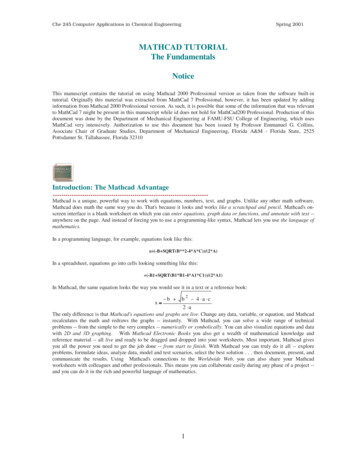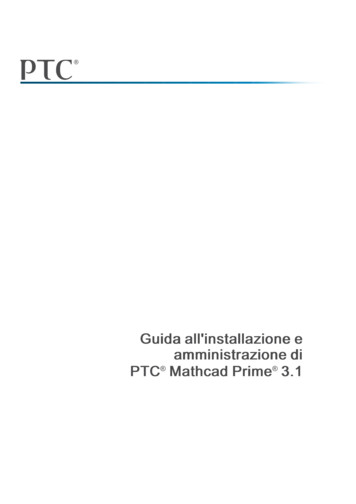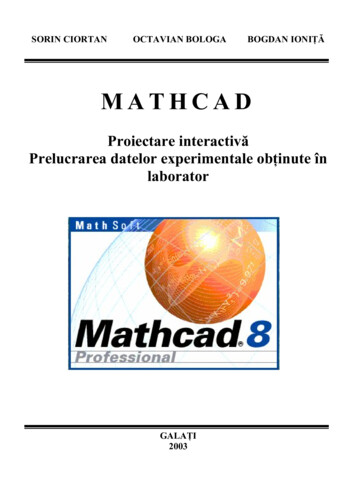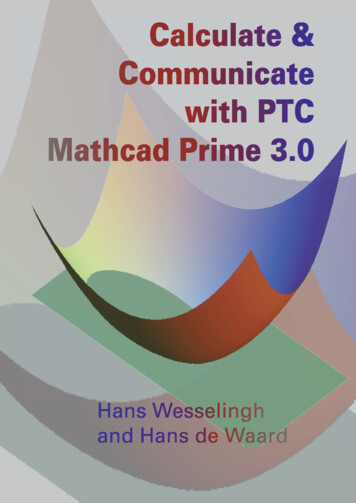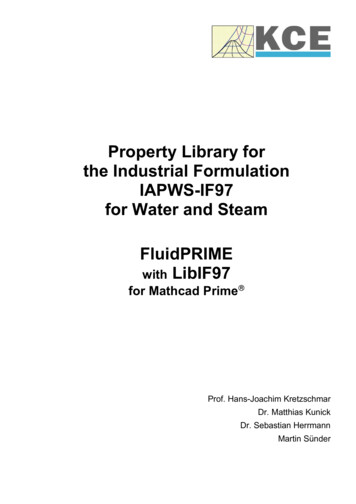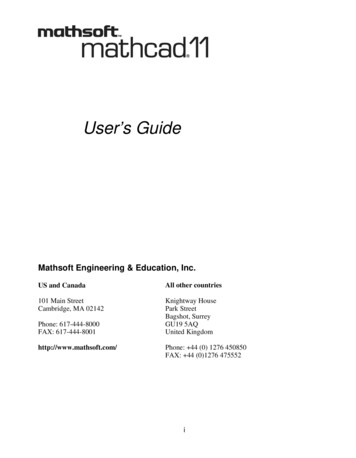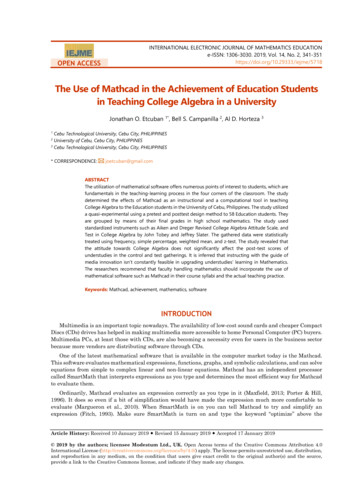
Transcription
OPEN ACCESSINTERNATIONAL ELECTRONIC JOURNAL OF MATHEMATICS EDUCATIONe-ISSN: 1306-3030. 2019, Vol. 14, No. 2, 341-351https://doi.org/10.29333/iejme/5718The Use of Mathcad in the Achievement of Education Studentsin Teaching College Algebra in a UniversityJonathan O. Etcuban 1*, Bell S. Campanilla 2, Al D. Horteza 3Cebu Technological University, Cebu City, PHILIPPINESUniversity of Cebu, Cebu City, PHILIPPINES3Cebu Technological University, Cebu City, PHILIPPINES12* CORRESPONDENCE:joetcuban@gmail.comABSTRACTThe utilization of mathematical software offers numerous points of interest to students, which arefundamentals in the teaching-learning process in the four corners of the classroom. The studydetermined the effects of Mathcad as an instructional and a computational tool in teachingCollege Algebra to the Education students in the University of Cebu, Philippines. The study utilizeda quasi-experimental using a pretest and posttest design method to 58 Education students. Theyare grouped by means of their final grades in high school mathematics. The study usedstandardized instruments such as Aiken and Dreger Revised College Algebra Attitude Scale, andTest in College Algebra by John Tobey and Jeffrey Slater. The gathered data were statisticallytreated using frequency, simple percentage, weighted mean, and z-test. The study revealed thatthe attitude towards College Algebra does not significantly affect the post-test scores ofunderstudies in the control and test gatherings. It is inferred that instructing with the guide ofmedia innovation isn’t constantly feasible in upgrading understudies’ learning in Mathematics.The researchers recommend that faculty handling mathematics should incorporate the use ofmathematical software such as Mathcad in their course syllabi and the actual teaching practice.Keywords: Mathcad, achievement, mathematics, softwareINTRODUCTIONMultimedia is an important topic nowadays. The availability of low-cost sound cards and cheaper CompactDiscs (CDs) drives has helped in making multimedia more accessible to home Personal Computer (PC) buyers.Multimedia PCs, at least those with CDs, are also becoming a necessity even for users in the business sectorbecause more vendors are distributing software through CDs.One of the latest mathematical software that is available in the computer market today is the Mathcad.This software evaluates mathematical expressions, functions, graphs, and symbolic calculations, and can solveequations from simple to complex linear and non-linear equations. Mathcad has an independent processorcalled SmartMath that interprets expressions as you type and determines the most efficient way for Mathcadto evaluate them.Ordinarily, Mathcad evaluates an expression correctly as you type in it (Maxfield, 2013; Porter & Hill,1996). It does so even if a bit of simplification would have made the expression much more comfortable toevaluate (Margueron et al., 2010). When SmartMath is on you can tell Mathcad to try and simplify anexpression (Fitch, 1993). Make sure SmartMath is turn on and type the keyword “optimize” above theArticle History: Received 10 January 2019 Revised 15 January 2019 Accepted 17 January 2019 2019 by the authors; licensee Modestum Ltd., UK. Open Access terms of the Creative Commons Attribution 4.0International License (http://creativecommons.org/licenses/by/4.0/) apply. The license permits unrestricted use, distribution,and reproduction in any medium, on the condition that users give exact credit to the original author(s) and the source,provide a link to the Creative Commons license, and indicate if they made any changes.
Etcuban et al.assignment statement containing the expression to simplify. If Mathcad finds a simpler form, it marks theexpression with a red asterisk (Liengme, 2015). To see the simplified form of the expression, double-click onthe asterisk. Mathcad uses this simpler form in all subsequent calculations (Benker, 2012; Guiñón et al., 2007).To make Mathcad optimize all assignments without your having typed “optimize” before each one, chooseSmartMath Controls from the Math menu, pull right and choose Optimize. Mathcad will optimize allassignments statements.Because of this fast pacing technology, mathematics instructors may utilize this software as aninstructional and computational tool in teaching Mathematics, specifically College Algebra, in theundergraduate programs. Teachers should update their strategies and methodologies in teachingMathematics for the growth and welfare of the students (Boekaerts & Corno, 2005; Llinares & Krainer, 2006;Zakaria et al., 2010).Students who enroll in the College of Teacher Education ought to be given able guidelines, adequateinstructional media, and satisfactory school hardware and offices to encourage them become mentally capablein the quest for knowledge. They should be enhanced with techniques and methods on how to handle subjectsusing the latest technology as an instructional tool. By providing them with sufficient instructional media andteaching the right techniques and methods, teachers, through Mathcad, can help students in acquiringknowledge, and themselves in becoming better teachers. According to Etcuban and Pantinople (2018) thatteachers are at the forefront of every learning institution. They teach and nurture the minds of students.The Commission of Higher Education (CHED) has implemented the use of Information Technology (IT) aspart of the curriculum in all private and public Higher Education Institutions (HEIs) in the Philippines. Theuse of the latest mathematical tool in teaching Mathematics in school would give advantages in teaching anda change in the trend of handling Mathematics, specifically, College Algebra.The purpose of this study is to know the effects of using Mathcad as an instructional and computationaltool in teaching College Algebra in the second year Education students. It aims to show that Mathcad wouldbe a great help in acquiring knowledge in Mathematics in general and College Algebra in particular. Moreover,it tries to answer these questions: Is it significant as an instructional and computational tool in teachingMathematics? Can this be endorsed to all colleges and universities as far as instructional media is concerned?FRAMEWORKThe study is anchored on Self-Efficacy Theory (SET), Social Cognitive Theory (SCT), and Cognitive LoadTheory (CLT).Self-efficacy is the faith in one’s capacity to impact occasions that influence one’s life and command overthe manner in which these occasions are experienced (Bandura, 1993). It has a noteworthy influence indeciding our odds for progress; in reality a few therapists rate self-adequacy above ability in the formula forprogress (Multon et al., 1991; Pajares & Schunk, 2001). We have to give careful consideration to self-viabilitywhen defining objectives to ensure that man’s adequacy convictions are in accordance with its points and notneutralizing them (Schunk, 1995).The fundamental idea in SCT is that a person’s activities and responses, including social practices andintellectual procedures, in pretty much every circumstance are impacted by the activities that individual hasseen in others (Bandura, 2014; Porter et al., 2003). The hypothesis expresses that when individuals watch amodel playing out a conduct and the outcomes of that conduct, they recall the grouping of occasions and utilizethis data to direct consequent practices (Kelder et al., 2015). Watching a model can likewise incite the watcherto take part in conduct they officially learned (Stahl et al., 2006). At the end of the day, individuals do notlearn new practices exclusively by attempting them and either succeeding or bombing, but instead, thesurvival of mankind is needy upon the replication of the activities of others (Bandura, 2014). Contingent uponwhether individuals are compensated or rebuffed for their conduct and the result of the conduct, the onlookermay reproduce conduct demonstrated (Strauss, 2017; O’Fallon & Butterfield, 2012). Media gives models to ahuge swath of individuals in a wide range of natural settings (Wilson & Myers, 2000).The CLT proposes that learning happens best under conditions that are lined up with human intellectualengineering (Paas et al., 2004). The structure of human subjective design, while not known definitely, isrecognizable through the consequences of test examine (Jones et al., 2009). It has been intended to give rulesproposed to aid the introduction of data in a way that empowers student exercises that upgrade scholarlyexecution (Valcke, 2002). Sweller’s hypothesis utilizes parts of data handling hypothesis to stress the342http://www.iejme.com
INT ELECT J MATH EDcharacteristic constraints of simultaneous working memory stack on picking up amid guidance (Van Gog etal., 2005). It makes utilization of the composition as essential unit of examination for the plan of instructionalmaterials (Kirschner, 2002).Multimedia will change the way people use their computers. As the power of the PCs catches up man’sability to dream, create and inform, the introduction of mathematical software will have a different impact inthe teaching of Mathematics specifically College Algebra.Interactive multimedia is not a product. It is a massive march of applied technologies that span the rangeof computer tasks. Desktop video and multimedia will touch no area in the computer industry. Offerseconomical alternatives to conventional methods through sound and video that are remarkably useful tools,offering easy user-interaction and, entirely just, fun. There is a line that connects education to entertainment,and it is multimedia that helps cross that line.Teaching models are based on theories of how students learn (Ramsden, 2003). The teacher must,therefore, list down steps toward attaining the desired learning outcomes (Kumaravadivelu, 2001). Effectiveteachers have learned to use a variety of teaching techniques to allow students to acquire what they want tolearn since teachers now recognize that students learn differently (Darling-Hammond, 2008). According toEtcuban (2013), the integration of science and innovation into instructional practices has made another roadin adopting new ideal models in educating students. The accessibility of tremendous data in the Internet andthe innovative headway help educators in the conveyance of exercises making it agreeable. Some studentslearn by watching, listening, and inquiring; others learn best by a group or social interactions, and still, othersneed special personal attention in order to learn. Again, it is emphasized that the more teaching skills andstrategies a teacher have at his command, the higher is the chance for more students to achieve the desiredlearning outcomes.The computer revolution is at hand. A computer is a tool, which may have multiple uses in the mathematicsclassroom. It may be a device for making the learning of concepts, skills, and problem solving more effectivethan that of traditional practice. Computer-assisted instruction reveals that students get a variety ofresponses by way of animation, graphics, and audio. Among areas surveyed that are beneficial to instructionare computer learning in Mathematics, computational skills, basic reading skills, and general education.Recent researches show that computer learning lends itself to positive attitudes towards learning, such as byway of increased motivation and improved self-esteem among learners.One way to adapt and capitalize the technological advances is to organize thinking on the use of media inthe teaching-learning process. Another will be to test the effectiveness of the latest technologies in the crucibleof the classroom and the context of particular learning situations. However, no matter how the teacher todayadapts himself to his new role, it becomes clear that the modern teacher has been provided with newopportunities to exercise his unique personal capabilities and to face the challenge of the technological age.The studies above clearly showed that the use of computers could be beneficial not only to the studentswho need sufficient instructional media but also to the teachers for them to grow professionally in theirpractice. When properly trained, students tend to increase their computational skills in College Algebra thus,mathematical software such as Mathcad assists educators in enhancing students’ learning.The researchers gained more insights into the teaching of Mathematics using technology by going over theprevious studies. However, his study differed in the following aspects: Mathcad was adapted as acomputational and instructional tool in teaching the subject, instead of Mathematica, Geometer’s Sketchpad,and any other mathematical software available in the computer market. Mathcad was used only in someselected topics in College Algebra.OBJECTIVES OF THE STUDYThis study identified the effects of Mathcad as an instructional and a computational tool in teachingCollege Algebra to the Education students in the University of Cebu, Philippines. Specifically, the study aimedto answer the: 1) Profile of the participants who enrolled in College Algebra, in terms of their age, sex, andaverage final Mathematics grade in High School in the control and experimental groups; 2) Students’ attitudestowards College Algebra, achievement in College Algebra in both groups; 3) Students’ performance in CollegeAlgebra; and 4) Significant difference between the attitudes towards College Algebra and the mean gainedfrom pre-test and post-test scores of both groups.http://www.iejme.com343
Etcuban et al.Table 1. Distribution of Research ParticipantsControl 4956.25Total13100.0016100.00f279Experiment 0.00METHODOLOGYIn this study, the experimental method of research was used. The experimental lasted for two weeks fromJune 10 - 24, 2018. The researchers did careful observation and measurement of results. The administrationof pre-test in College Algebra to both groups was given last June 10, 2018, and the post-test on June 24, 2018.Time accuracy of each test was one hour and thirty minutes.This experimental study made use of the group design using two groups as its subjects: the control and theexperimental groups. The research respondents were divided into two groups according to Average FinalMathematics Grade in High School. To make the two groups comparable, the researchers arranged their gradefrom highest to lowest, then randomly assigned the respondents either to control group or experimental group.The control group received teaching methodologies and techniques without the aid of Mathcad as aninstructional and computational tool, while the experimental group utilized Mathcad as an instructional andcomputational tool in addition to the usual teaching methodologies and techniques received by the controlgroup.The said groups were given precisely the same set of the course outline and class activities. Such activitiesincluded classroom exercises, board work, examinations, assignments, and discussions. The two groups weregiven a standardized test in College Algebra to find out the performance of the students, which was evaluatedthrough the scores acquired. This examination was used to determine whether or not the instructional andcomputational tool, which was the Mathcad, has a significant effect on the learning process.The control group was given the methods of teaching as follows: class discussions and problem illustration,evaluation of students’ learning through written examinations, seatwork, board work, and assignments forfurther study and computations. In the experimental group, the method of teaching was the same as thecontrol group. However, there were times during discussions that the teacher used Mathcad as aninstructional and computational tool in teaching and solving problems in College Algebra. Students askedquestions on how to manipulate the mathematical software.Data were collected, tabulated, analyzed, and interpreted from the given attitudinal and standardized testsin College Algebra. A comparison was then made based on the results obtained by the two groups. Remedialmeasures were then proposed to improve students’ performance and learning outcomes in College Algebrabased on the experimental study.The study conducted at the University of Cebu Main Campus, College of Teacher Education. TheUniversity is located in the heart of Cebu City, Philippines.There were 58 participants consisted of 15 Bachelor in Secondary Education (BSED) and 43 Bachelor inElementary Education (BEED) students. Each participant has already taken Basic Mathematics as aprerequisite to the College Algebra course. Most of them have attended their second course in public schools.Further description of the two groups is summarized in Table 1.The researchers used three-sets of instruments. The first instrument used is Form 138-A (ScholasticRecord Form) of students. This was used to get the students’ average final mathematics grade in high school.The second instrument is the standardized Aiken and Dreger Revised College Algebra Attitude Scale. Thiswas used to determine the attitudes of the students towards the subject. The students using the five-pointscale accomplished the test: 5 points for Strongly Agree, 4 points for Agree, 3 points for Undecided or Not Sure,2 points for Disagree, and 1 point for Strongly Disagree. The third instrument is the Standardized Test inCollege Algebra by John Tobey and Jeffrey Slater. This was used to measure the achievement of the studentsin College Algebra and to determine whether or not mathematical software had a significant effect on thelearning process.344http://www.iejme.com
INT ELECT J MATH EDTable 2. Profile of the Participants in College AlgebraControl Group(n 29)f%Age (in years)24 - 2713.4520 - 231137.9316 - 191758.62SexMale1344.83Female1655.17Grade95 – 100 (Excellent)13.4590 – 94 (Very Good)310.3480 – 89 (Good)1965.5276 – 79 (Fair)517.2475 (Passing)13.45Experimental Group(n 220.693.45The second year Educations students in the control and the experimental groups were used as theparticipants of this experimental study. The same teacher in College Algebra handled both groups. Thefollowing procedures were done to gather data. First, the researchers conducted a Standardized Pre-test inCollege Algebra to the two groups. Then, they gave to the experimental group discussions and hands-ontutorials on Mathcad as an instructional and computational tool teaching and solving some selected topics inCollege Algebra. In the control group, some selected topics in College Algebra that make use of the traditionaland usual teaching methods were discussed. Then, the researchers gave a Standardized Post-test in CollegeAlgebra to both groups. Next, the researchers evaluated students’ attitude towards College Algebra in bothcontrol and experimental groups. The data were collected, tabulated, analyzed, and interpreted usingfrequency, simple percentage, weighted mean, and z-test. The study assumed that the population means areequal.RESULTS AND DISCUSSIONSEvaluation is an intricate process. Before it is finalized, data must be gathered, presented and studied.After the critical analysis of the data, they are interpreted. From the interpretation, one could perceive theoutcomes, whether the venture succeeded or failed.Profile of the ParticipantsThe profile of the participants under this experimental study consists of age, sex, and average finalmathematics grade in high school, attitudinal test, and their pre-test and post-test scores from thestandardized College Algebra test.Table 2 shows that only 1 or 3.45% belonged to the age bracket of 24 to 27 of both groups. The age bracketof 20 to 23 of the control and experimental groups got 11 and 6 respectively. While the age bracket of 16 to 19got the highest distribution score of 17 and 22 for both groups. From the data above, it can be implied thatrespondents in both groups are equivalent regarding age levels. Most of them fall on the same age categorywhich means respondents can be classified as teenagers.Also, the table presents that there were 13 males and 16 females that belonged to the control group. Theexperimental group had 9 males and 20 females. Furthermore, the table presents that there were more femalestudents enrolled in College Algebra than male students. It can be said that there were more femalerespondents than male respondents than male respondents in both groups. This implies that there are morefemale students enrolled in College Algebra than male students.The table presents that most of the respondents in both control and experimental groups fell under thecategory Good, which grade range from 80 to 89. Furthermore, the table shows that both groups arecomparable. It is assumed that the indication used in this study can affect the learning capabilities of thestudents, specifically College Algebra. It implies that both groups were equivalent and comparable regardingaverage final mathematics grade in high school. This implies that majority of the learners in College Algebrawere average as to analytical capabilities.http://www.iejme.com345
Etcuban et al.Table 3. Distribution of Students’ Attitudes in College AlgebraControl Group(n 29)Raw ScoreDescriptionf%189 - 225Strongly Agree00.00153 - 188Agree724.14117 - 152Undecided1862.0781 - 116Disagree413.7945 - 80Strongly Disagree00.00Table 4. Distribution of Students’ Performance in College AlgebraControl Group(n 29)GradeDescriptionPre-testPost-testf%f%16 - 20Excellent26.9012 - 15Very Proficient310.34620.698 - 11Proficient26.90827.594-7Less ntal Group(n 29)f%00.00931.031758.62310.3400.00Experimental Group(n 310.34310.341137.932172.41931.04Students’ Attitudes in College AlgebraTable 3 shows that no one in the control and experimental groups could strongly agree, nor stronglydisagree with the indicators given in the attitudinal test. Most of the respondents were undecided, or theywere not sure with the statements found in the said test.Based on the table, it can be said that respondents both in control and experimental groups were seeminglyequivalent and comparable with each other, as to students’ attitude in College Algebra. Furthermore, itimplies that the majority of the respondents were undecided or they were not sure with the statements foundon the attitudinal test.According to Domino (2009) that teachers influenced students’ understanding and attitudes towardmathematics through the way that they taught mathematics, by making certain that their studentsunderstood mathematics, and through their personalities. In particular, students claimed that theyunderstood and liked mathematics when their teachers had fun and interesting lessons, had the studentsactively engaged in the classroom, showed the students how the mathematics that they were learning wasrelated to their lives, taught at a relatively slow pace, helped students outside of the classroom thought aboutthere lessons, and were eager about mathematics. Students claimed that they did not understand and dislikedmathematics when their teachers had boring monotonous lessons, did not have the students actively involvedin the classroom, did not show students the relevance and importance of learning mathematics, taught at arapid pace, did not encourage student questions in the classroom, were not available to help students outsideof the classroom, did not seem to care about their students, and showed no enthusiasm about teachingmathematics.Small (2002) says that College Algebra blocks the scholastic chances and plans for roughly 200,000understudies for every semester. Members concurred that we ought not to acknowledge this imperative ofhuman potential. Essential, in any case, is the way that few enhanced College Algebra programs haveprevailing with regards to bringing down disappointment grades while turning around the negativedemeanors of students towards mathematics.Students’ Performance in College AlgebraTable 4 presents the results of students’ performance in College Algebra.Table 4 reveals that the pre-test scores obtained by the respondents of both groups were very low. Thedata imply that there is a need for improving students’ mathematical skills. More practice drills, examples,homework, as well as board work, are needed to help sharpen analytical capabilities of the learners.Furthermore, the table shows the increasing results of the post-test scores of the control group. It implies thatthere is an increase in learning among the students of the control group in College Algebra.346http://www.iejme.com
INT ELECT J MATH EDTable 5. Pre-test and Post- Comparisons of Students’ Attitudes towards College AlgebraMeanStDevGroupPre-test Post-test Pre-test Post-test z value cv at 0.05 ignificantHo icantHo rejectedOn the other hand, in the experimental group, the pre-test results were more likely the same as that of thecontrol group. However, during the post-test examination, students in the control group gained more than theexperimental group. Thus, it means that Mathcad did not satisfactorily contribute and enhance students’learning, specifically in College Algebra. The table also implies that respondents in the experimental groupwere not ready in the use of computers as a tool in learning Mathematics. Learning Mathematics at the sametime learning computers was difficult for them to adjust. They were cyberphobic since it was the first timethey used computers.College Algebra is a required, center course for some sciences and arithmetic majors in differentuniversities. The course had the most minimal passing rate of any class on grounds. The organizationcommunicated an unmistakable goal to enhance this high disappointment rate and gave assets to achieve thisreason. The investigation of Wynegar and Fenster (2009) demonstrated that the customary addressconveyance framework had the most astounding evaluation point normal and one of the least falling flat ratesof teaching strategies.The study of Hauk et al. (2015) revealed no significant differences in College Algebra achievement gain byhomework group, when statistically controlling for previous mathematics achievement. Results support theconjecture that web-based homework is at least as effective as traditionally graded paper-and-pencilhomework for understudies learning College Algebra in tolerably estimated address-based classes.Significance of DataThe study hypothesized that the attitude of the students towards the course in the control andexperimental groups does not affect the post-test scores. Secondly, it was also hypothesized that the attitudestowards College Algebra of both groups are not significantly related. Lastly, there is no significant differencebetween post-test scores of the control and experimental groups.Table 5 presents the relationship of two groups in contrast to the attitudes of the students towards CollegeAlgebra.The table shows the statistical comparison of both groups on post-test scores. The results indicate therejection of the null hypothesis, which says that the attitude towards College Algebra does not significantlyaffect the post-test scores of students in the control and experimental groups. The computed value of z is higherthan the critical value of 1.67 at 0.05 level of significance of the df of 29. Based on the data on the table, itimplies that teaching mathematics through the use of Mathcad, significantly affect student’s achievement inCollege Algebra.The discoveries of the investigation of Gallo and Odu (2009) recommend that albeit numerous studentsmay lean toward escalated courses or packed timetables that limit the time they spend on grounds, theseplanning choices may not be ideal for learning, in any event not in science.The study of Isiksal and Askar (20005) suggests that students showed great enthusiasm for a mathematicalsoftware. Students in the experimental group had the highest scores compared to other groups regardingmathematics achievement and mathematics self-efficacy.Taylor (2008) conducted a study on mathematics anxiety and attitudes toward mathematics. It determinedif the technology course lowered mathematics anxiety, as well as improved attitudes. The findings of foundthat students executed and additionally the control group taught by lecture. The anxiety of the experimentalgroup diminished more than the control gathering, and the trial gathering’s demeanor toward mathematicsenhanced at a more prominent rate than the control group.The investigation of Hodges and Kim (2013) was directed to explore the adequacy of a treatment intendedto enhance College Algebra students toward mathematics. Factually noteworthy outcomes were watched forenhanced mentalities toward mathematics.Table 6 presents the relationship between the students’ attitude in College Algebra of the control andexperimental groups.http://www.iejme.com347
Etcuban et al.Table 6. Comparison of Mean Scores of Student’s Attitude of Both GroupsGroupMeanStDevz Value cv at 0.05dfSignificanceControl136.9322.951.291.6756Not SignificantExperimental143.9718.39Table 7. Comparison of the Post-test Mean Scores of the Control and Experimental GroupsGroupMeanStDevz Value cv at 0.05dfSignificanceControl7.795.330.561.67156Not SignificantExperimental7.005.48ResultHo acceptedResultHo acceptedThe table reveals that the attitudinal mean of the experimental group is higher than the attitudinal meanof the control group. Furthermore, the z value of 1.29 is less than the critical value of 1.67 at 0.05 level ofsignificance of the df of 56. This implies the acceptance of the null hypothesis, which says that the attitudestowards College Alg
the asterisk. Mathcad uses this simpler form in all subsequent calculations (Benker, 2012; Guiñón et al., 2007). To make Mathcad optimize all assignments without your having typed optimize" before each one, choose " SmartMath Controls from the Math menu, pull right and choose Optimize. Mathcad will optimize all assignments statements.


